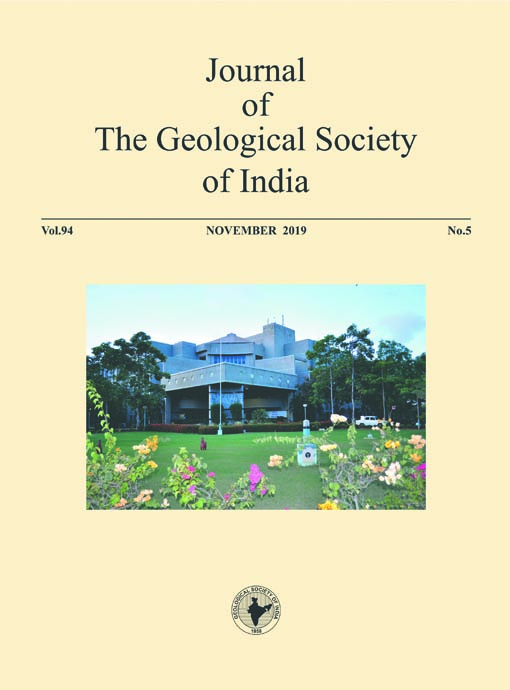Assessment of Domestic Water Use Pattern and Drinking Water Quality of Sikkim, North Eastern Himalaya, India: A Crosssectional Study
DOI:
https://doi.org/10.1007/s12594-019-1348-9Keywords:
No Keywords.Abstract
The present study focused on the pattern of domestic water consumption in Sikkim state of India along with the assessment of the hydro-chemical and hydrobiological characteristics of drinking water quality. The pattern of water consumption and socioeconomic status were acquired through questionnaires and interview of 98 households in three major towns of Sikkim e.g. Gangtok, Ravangla and Pelling. Results showed that the hydro-chemical parameters of drinking water were less than maximum permissible limit as prescribed by the World Health Organization (WHO) and Bureau of Indian Standards (BIS). Total coliforms, Escherichia coli, Enterococcus spp., Salmonella sp., Staphylococcus spp. and P. aeruginosa were detected in 80.2, 47.5, 49.8, 55.2 and 75 percent of the drinking water samples respectively. However, a careful household survey reveals that about 43% of respondents suffered from water-borne diseases during the monsoon period. For this reason 60% of people prefer boiling or detoxify the water before drinking.Downloads
Metrics
Issue
Section
Downloads
Published
How to Cite
References
American Public Health Association. American Water Works Association (1998) Water Environment Federation (APHA-AWWAWEF), Standard methods for the examination of water and wastewater, Washington, D.C.
Briscoe, J. and DeFerranti, D. (1988) Water for rural communities: Helping people help themselves. Washington, DC. The World Bank, pp.32-34.
Dieterich, B.H. and Henderson, J. (1963) Urban water supply conditions and needs in seventy-five developing countries. Switzerland, Geneva. World Health Organization Public Health Papers, No. 23. Fars Province Rural Water and Wastewater Department (FPRWWD).
Doulati Ardejani, F., Jodeiri Shokri, B., Bagheri, M. et al. (2010) Investigation of pyrite oxidation and acid mine drainage characterization associated with Razi active coal mine and coal washing waste dumps in the Azad shahr–Ramian region, northeast Iran. Environ. Earth Sci., v.61, pp.1547.
Fadaei A, Sadeghi, M. (2014) Evaluation and Assessment of Drinking Water Quality in Shahrekord, Iran. Resources and Environment, v.4(3), pp.168-172.
Gleick P.H. (1996) Basic water requirements for human activities: Meeting basic needs. Water International, v.21(2), pp.83–92.
Gopaldas, T. and Gujral, S. (1995) Girl child and environment. Social Change, v.25(2–3), pp.226–234.
Joshi, M., Tiwari, A.N. (2009) Structural events and metamorphic consequences in Almora Nappe, during Himalayan collision tectonics. Jour. Asian Earth Sci., v.34, pp.326-335.
Kashi, G. and Khoshab, F. (2015) An Investigation of the Chemical Quality of Groundwater Sources. Donnish Jour. Res. Environ. Stud., v.2(3), pp.18-27.
Kumar, M. and Puri, A. (2012) A review of permissible limits of drinking water. Indian Jour. Occupational and Environmental Medicine, v.16(1), pp.40-44.
Kumar, R., Singh, R.D., Sharma, K.D. (2005) Water resources of India. Curr. Sci., 2005, v.89(5), pp.794–811.
Mohsin M, Safdar S, Asghar F, Jamal F. (2013) Assessment of Drinking Water Quality and its Impact on Residents Health in Bahawalpur City. Internat. Jour. Humanities and Social Sci., v.3(15), pp.114-128.
Oladipo, I.C., Adeboye, O.A. (1995) Physico-Chemical and Bacteriological Analysis of Well Water Used for Drinking and Domestic Purposes in Ogbomosho, Nigeria. Internat. Jour. Curr. Microbiol. Appl. Sci., v.4(9), pp.136-145.
Rao K.L. (1975) India's water wealth. New Delhi: Orient Longman Ltd.
Sarda, P. and Sadgir, P. (2015) Assessment of Multi Parameters of Water Quality in Surface Water Bodies-A Review. Internat. Jour. Res. Appld. Sci. Engg. Tech., v.3(VIII), pp.331-336.
Shaban, A., Sharma, R.N. (2007) Water consumption pattern in domestic households in major Indian cities. Economic and Political Weekly, v.9(23), pp.2190–2197.
Sharma, N.P., Damhaug, T., Gilgan-Hunt, E., Grey, D., Okaru, V., and Rothberg, D. (1996) African water resources: Challenges and opportunities for sustainable development. Washington, DC. World Bank Technical Paper No. 331.
Sheat A. (1992) Public perception of drinking water quality: Should we care?. Christchurch, New Zealand: New Zealand Water Supply and Disposal Association Annual Conference.
Shilajyan, H.A. (2013) Electrical conductivity of potassium salt - dimethylsulfoxide – water systems at different temperatures. Proc. Yerevan State University, v.1, pp.3-6.
Sikkim State Tourism Policy, Government of Sikkim (2016) Available at: http://www.sikkimtourism.gov.in/Webforms/General/pdf/Policy.pdf
Singh, K., Hundal, H.S., Khurana, M.P.S. (2013)An appraisal of groundwater quality for drinking and irrigation purposes in southern part of Bathinda district of Punjab Northwest India. Environ. Earth Sci., v.70, pp.1841-1851.
Sun, X., Bernard-Jannin, L., Garneau, C., Volk, M., Arnold, J.G., Srinivasan, R., Sauvage, S., Sanchez-Pérez, José-Miguel (2015) Improved simulation of river water and groundwater exchange in an alluvial plain using the SWAT model. Hydrological Processes, v.30(2), pp.187-202.
Tiwari, A. (2012) Water quality and quantity analysis in Sikkim, North Eastern Himalaya. Curr. Sci., v.103(1), pp.41-45.
Wheida, E. and Verhoeven, R. (2007) An alternative solution of the water shortage problem in Libya, Water Resour. Managm., v.21(6), pp.961-982.
World Health Organization (2015) Antimicrobial resistance: An emerging water, sanitation and hygiene issue. WHO reference number: WHO/FWC/WSH/ 14.7. Available at: http://www.who.int/water_sanitation_health/publications/antimicrobial-resistance/en/
World Health Organization (2003) Domestic Water Quantity, Service Level and Health, WHO/SDE/WSH/03.02. Available at: http://www.who.int/ ater_sanitation_health-/diseases/WSH03.02.pdf
World Health Organization (1997) Guidelines for drinkingwater quality: surveillance and control of community supply, Vol. 2 (2nd ed.). Geneva, Switzerland: WHO.
World Health Organization (1992) Report on the WHO commission on health and environment. Geneva, Switzerland: WHO.

 Pravat Kumar Shit
Pravat Kumar Shit






